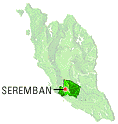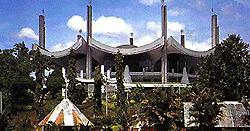![]() Johor
Johor
![]() Malacca
Malacca
![]() Negeri Sembilan
Negeri Sembilan
![]() Selangor
Selangor
![]() Perak
Perak
![]() Kedah
Kedah
![]() Perlis
Perlis
![]() Pahang
Pahang
![]() Terengganu
Terengganu
![]() Kelantan
Kelantan
![]() Penang
Penang
![]() Sabah
Sabah
![]() Sarawak
Sarawak
![]() Kuala Lumpur
Kuala Lumpur
![]() Labuan
Labuan
![]() Putrajaya
Putrajaya


Negeri Sembilan is state in the southwestern part of Malaysia,
bordered by the states of Melaka, Johor, Selangor, and Pahang.
Negeri Sembilan is in the region called West Malaysia (Peninsular
Malaysia) and covers an area of about 6500 sq km (2510 sq mi).
Negeri Sembilan lies almost completely inland and has only 48 km
(30 mi) of coastline, which includes Port Dickson. Its main crops
are rice, fruit, and rubber, and the state is linked to the
national east-west road. Seramban is the capital.
The tribal chiefs of the state are descended from Minangkabau leaders who came from Sumatra in the 14th century, bringing a matrilineal social system embodied in the adat perpateh laws. This means that property is inherited through the female line. Negeri Sembilan also has the distinction of being a federation within a federation. Its name means “nine states,” referring to a loose federation formed in 1773 which came under British protection in 1874, before becoming one of the Federated Malay States in 1895. In 1957 Britain granted independence to the Federation of Malaya (the forerunner of Malaysia), which included Negeri Sembilan and the rest of Peninsular Malaysia. The nine states have now become just five: Kuak Sungai Ujong, Luak Jelebu, Luak Johol, Luak Rembau, and Luak Tampin. The state's ruler, the yang dipertuan besar, is still elected from among the clan chiefs, a procedure unique to the state. The present yang dipertuan besar, Ja’afar ibni Abdul Rahman, was named the supreme head of Malaysia in 1994, in an election among the country's nine heriditary rulers. Population (1991 census) 691,150.
 By the mid-nineteenth century, there was a loose
coalition of nine states inhabited mostly by Minangkabau. Each
state had its own leader and a system was created whereby the
head of the coalition will rotate among the nine chiefs. This
rotation system has been adopted by present-day Malaysia for the
appointment of the country's Agong, or King. In the sixteenth and
seventeenth century Negeri Sembilan experienced an immigration of
the Minangkabau people from Sumatera. They settled in areas such
as Naning, Sungai Ujong and Rembau which were areas were
initially under the influence of the Johor-Riau Empire, to the
extent that a Datuk was installed to oversee Johor conquests in
Negeri Sembilan.
By the mid-nineteenth century, there was a loose
coalition of nine states inhabited mostly by Minangkabau. Each
state had its own leader and a system was created whereby the
head of the coalition will rotate among the nine chiefs. This
rotation system has been adopted by present-day Malaysia for the
appointment of the country's Agong, or King. In the sixteenth and
seventeenth century Negeri Sembilan experienced an immigration of
the Minangkabau people from Sumatera. They settled in areas such
as Naning, Sungai Ujong and Rembau which were areas were
initially under the influence of the Johor-Riau Empire, to the
extent that a Datuk was installed to oversee Johor conquests in
Negeri Sembilan.
The disintegration of the Johor-Riau Empire and the onset of the Bugis Sultanate in Melaka precipitated insurrections in Rembau, Sungai Ujong, Johol and Ulu Muar in 1770. The Minangkabaus then turned to the Pagar Ruyong royal house in their Sumateran homeland for a ruler who could protect them. Consequently, Raja Melewar was proclaimed the first Yang Dipertuan Besar of Negeri Sembilan in 1773. The tumult in Negeri Sembilan threatened the tin trade with the Straits Settlements. This led to British intervention, and the subsequent installation of a British Resident. Martin Lister was the first British Resident in Negeri Sembilan.
Sir Frank Swettenham in 1893 proposed the formation of a federation to Sir Cecil Clementi Smith. This was to unite the states of Selangor, Perak, Pahang and Negeri Sembilan under a central administration, since the Resident system was found to be somewhat ineffectual. The British government concurred with this proposal and mandated Swettenham to obtain the agreements of the Malay Sultans. With the Sultans' agreement, the Federation of Malaya Agreement was successfully ratified in 1896. These states became the Federated Malay States under the rule of a Resident-General, becoming British protectorates in the process. Swettenham was appointed as the first Resident-General.
The
Japanese invasion in 1941 led to the dismantling of the structure
of the Federated Malay States. With the Japanese surrender,
Negeri Sembilan was placed under the British Military
Administration from September 1945 to early 1946. The British in
London formed the Malayan Peninsula Planning Unit in 1943, and on
10 October 1945, the Malayan Union scheme was laid out before the
British Parliament. A day later, Sir Harold MacMichael was sent
to the Malayan Peninsula to obtain the agreement of the Malay
Rulers. According to this agreement, Pulau Pinang, Melaka and 9
other Malay states were united under the Malayan Union. Malay
opposition derailed the Malayan Union plan, and the Malays under
Dato' Onn Jaafar's leadership formed the United Malays National
Organisation (UMNO) on 11 May 1946. The Malay Federation was
founded on 1 February 1948, the first step towards independence,
and on 31 August 1957, independence was achieved.

Towns & Infrastructure
Nature
Islands & Beaches
Area
6,643 square km
State Capital
Seremban
Royal Town
Sri Menanti
Administrative Divisions
7 (Jelebu, Jempol, Kuala Pilah, Port Dickson, Rembau, Seremban,
Tampin)
Sub-Administrative Divisions
62
Population
830,080 (2000)
Breakdown of Races (1994)
![]() States
States
![]() Tourism
Tourism
![]() National Symbols
National Symbols
![]() History
History
![]() Geography
Geography
![]() Flora & Fauna
Flora & Fauna
![]() Economy
Economy
![]() Culture
Culture
![]() Festivals
Festivals
![]() Transportation
Transportation
![]() Accommodation
Accommodation
![]() Foreign Exchange
Foreign Exchange
![]() Food
Food
![]() Fruits
Fruits